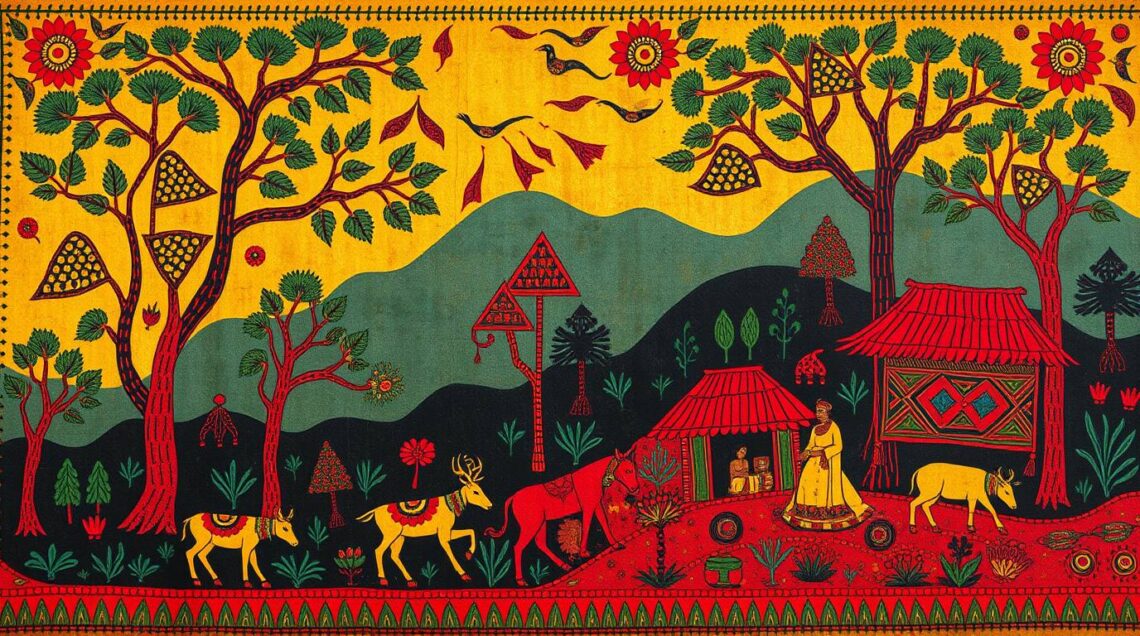
Bhil Art Painting: Bringing Tribal Traditions to Contemporary Canvas
India’s tribal communities have long been the guardians of rich artistic traditions, blending storytelling, spirituality, and nature into vibrant visual expressions. Among these, Bhil Art Painting stands out as one of the most distinctive forms of tribal art, celebrated for its intricate patterns, dynamic compositions, and symbolic narratives. Originating from the Bhil tribe, predominantly found in Madhya Pradesh, Rajasthan, Gujarat, and Maharashtra, Bhil art reflects the community’s deep connection with forests, animals, and the cycles of daily life.
The bhil handmade art painting tradition preserves the authenticity and cultural essence of this tribal practice. Renowned artists like Bhuri Bai have been instrumental in bringing Bhil art to contemporary platforms, bridging the gap between traditional storytelling and modern aesthetic appreciation. Their efforts ensure that the art thrives while staying true to its heritage.
Historical Background of Bhil Art
Bhil art has its roots in the daily and spiritual life of the Bhil tribe, one of India’s oldest indigenous communities. Traditionally, the paintings adorned the walls of tribal homes, especially during religious ceremonies, festivals, and weddings. These artworks were more than decorative—they served as cultural records, documenting community beliefs, rituals, and ecological knowledge.
The motifs in Bhil art are deeply tied to nature. Animals, birds, trees, rivers, and celestial bodies frequently appear in compositions, representing fertility, harmony, and spiritual significance. Human figures are often depicted engaging in everyday activities such as farming, hunting, dancing, or participating in tribal rituals. This narrative-driven approach has allowed Bhil art to preserve centuries of tribal wisdom, making each painting a living cultural document.
Techniques and Materials in Bhil Handmade Art Painting
The uniqueness of bhil handmade art painting lies in its techniques and natural materials. Traditionally, artists used pigments derived from minerals, soil, plants, and charcoal. These natural colors—red, yellow, green, blue, black, and white—create the bold and striking aesthetic that Bhil art is known for. Brushes are handmade from twigs, bamboo sticks, or even fingers, giving each artwork a deeply personal and tactile quality.
One of the defining features of Bhil painting is the dotted technique, where lines and figures are filled with intricate dots to create texture, depth, and rhythm. This method allows artists to convey movement and energy, whether illustrating animals in motion, humans dancing, or natural elements in their environment.
Modern Bhil paintings are increasingly created on canvas, paper, and textiles, expanding the reach of this tribal art form to urban and global audiences. Despite these adaptations, the handmade authenticity and symbolic richness of the art remain intact, ensuring that the cultural narrative continues to be preserved.
Symbolism and Themes in Bhil Art
Bhil art is deeply symbolic, reflecting the tribe’s beliefs, mythology, and relationship with nature. Animals like deer, elephants, and peacocks symbolize vitality, fertility, and harmony, while birds often represent freedom and spiritual aspiration. Human figures are depicted performing communal activities or rituals, emphasizing the interdependence of humans, community, and environment.
The dotted technique is not merely decorative; it represents energy, life, and continuity. Geometric patterns and repeated motifs symbolize rivers, forests, mountains, and sacred spaces. Through these layered compositions, Bhil paintings tell complex stories that combine mythology, daily life, and environmental consciousness, transforming each artwork into a cultural narrative.
Role of Artists in Preserving Bhil Art
Artists like Bhuri Bai play a crucial role in sustaining and promoting Bhil art. Through workshops, exhibitions, and collaborations with cultural organizations, they bring Bhil art to broader audiences while maintaining its authenticity. By teaching traditional techniques and the symbolic significance behind each motif, these artists ensure that new generations understand the cultural context and technical skills required for Bhil art.
Their work also provides economic opportunities for tribal communities, enabling artists to sustain traditional practices while gaining recognition in urban and global art markets. This combination of preservation, education, and commercial viability ensures that Bhil handmade art painting remains a living and evolving tradition.
Bringing Bhil Art to Contemporary Canvas
One of the most remarkable aspects of Bhil art is its adaptability. While it was historically practiced on walls and floors for ritualistic purposes, today it can be seen on contemporary canvases, home interiors, fashion textiles, and lifestyle products. The geometric patterns, bold colors, and narrative depth of Bhil paintings make them ideal for modern applications while retaining their tribal essence.
Interior designers use Bhil motifs in murals, wall panels, and furniture, introducing tribal storytelling into modern homes. Fashion designers incorporate the vibrant dotted patterns into clothing and accessories, merging traditional craftsmanship with contemporary design. Digital platforms and online galleries have further expanded the reach of Bhil art, connecting tribal artistry with global collectors who value handmade, culturally rich artworks.
Challenges in Preserving Bhil Art
Despite its growing popularity, Bhil art faces challenges, including commercialization, imitation, and erosion of traditional techniques. Mass-produced copies can undermine the authenticity and cultural value of bhil handmade art painting.
Preservation efforts focus on education, training, and cultural promotion. Artists like Bhuri Bai, along with NGOs and cultural organizations, conduct workshops, exhibitions, and mentorship programs to ensure that the traditional techniques, symbolism, and narratives are preserved. These efforts help maintain the integrity of Bhil art while providing sustainable livelihoods to tribal artists.
Why Bhil Art Painting is a Tribal Treasure
Bhil art is a tribal treasure due to its handmade authenticity, symbolic richness, and visually striking aesthetic. Each painting carries cultural narratives, spiritual beliefs, and ecological awareness, making it more than just decorative art. Its dotted patterns and geometric compositions create a distinct style instantly recognizable as Bhil art.
The adaptability of Bhil art to contemporary mediums ensures its continued relevance, while the dedication of artists like Bhuri Bai guarantees that the art form is respected and celebrated. Bhil paintings are treasured not only for their beauty but also as a vital record of India’s tribal heritage.
Conclusion
Bhil Art Painting represents the creativity, spirituality, and cultural heritage of India’s Bhil community. Its dotted patterns, vibrant colors, and symbolic storytelling make it a unique and enduring art form. As a bhil handmade art painting, it preserves centuries of tribal knowledge, rituals, and environmental awareness, providing a visual narrative of the Bhil way of life.
Through the work of artists like Bhuri Bai, Bhil art has transcended traditional contexts, finding a place in contemporary galleries, homes, and global art markets. Supporting and promoting Bhil art is not just about appreciating its visual appeal—it is about honoring a living cultural tradition, preserving tribal identity, and celebrating the rich legacy of India’s indigenous communities. By embracing Bhil Art Painting, we ensure that this vibrant tribal heritage continues to inspire, educate, and captivate art lovers, preserving India’s rich folk legacy for generations to come.
You May Also Like

How Local SEO and Technical SEO Work Together for Success
April 16,
Top 10 Data Analytics Services Providers in USA – Must to Watch
November 17,


